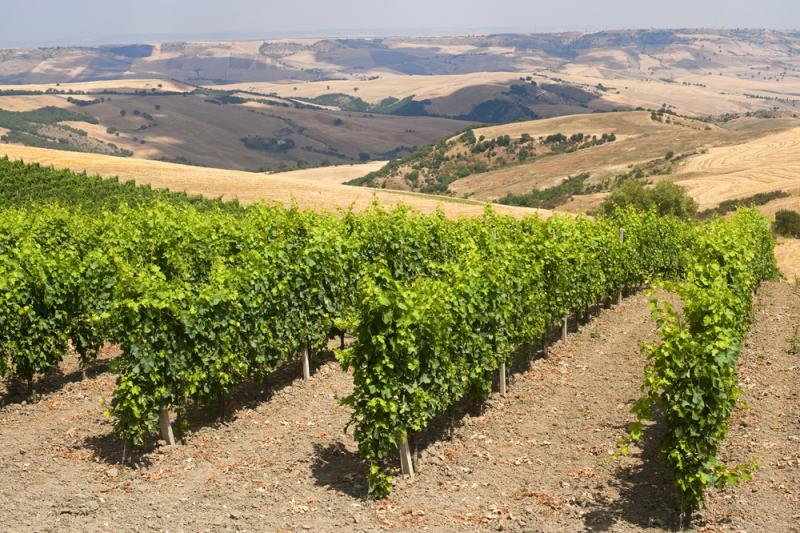We continue our exploration of Italy’s wine villages moving to the center and south of Italy. Read Part One here.
Montefalco (Umbria)
Montefalco is located on a hill overlooking the plains of the Clitunno and Topino rivers, 472 meters above sea level, and is surrounded by vineyards and olive groves.
The wine produced in the area is Sagrantino, an intense ruby red wine whose name derives from the Franciscan friars who harvested its grapes to obtain a passito wine intended for religious services. Sagrantino has been made in Umbria since the 16th century, and today it boasts the DOCG label; it can only be produced in Montefalco and partly in the towns of Gualdo Cattaneo, Castel Ritaldi, Bevagna and Giano dell'Umbria, near Perugia. With a scent reminiscent of blackberries and a dry and balanced flavor, it pairs well with savory dishes such as wild boar stew.

Among Montefalco’s highlights are the beautiful walls with the crenellated Porta di Sant'Agostino and its towers; the 13th-century Church of Sant'Agostino, which contains frescoes by Ambrogio Lorenzetti; the Piazza del Comune, with the 13th-century Palazzo Comunale (Town Hall); and the many churches and chapels.
Plan a visit in May, when the “Cantine Aperte” event, for the chance to visit the local wineries, or in September for “Enologica Montefalco,” when the new Sagrantino harvest is presented.
Offida (Marche)
In the area around Offida, a village between the valleys of Tesino and Tronto rivers, in the Marche region, the white Pecorino DOCG is produced: a straw-yellow with greenish reflections wine, which pairs well with seafood dishes, fresh cheeses and white meats.

Offida stands on a rocky spur in the heart of the Ascoli Piceno lands, and boasts many architectural jewels, including the beautiful 14th-century Church of Santa Maria della Rocca, one of the most important monuments in the region , built in brick in Romanesque-Gothic style; the Town Hall, dating back to the 13th-14th century, with its beautiful façade featuring a portico with seven arches and a loggia with 14 arches; inside there is a small art gallery. Many picturesque churches, medieval walls and towers dot the area.
Venosa (Basilicata)
The ancient village of Venosa, in the southern region of Basilicata, stands on a volcanic spur, and is rich in archaeological sites, evidence of the different cultures that passed by the area.
Aglianico is the typical wine produced here, which probably originated in Greece and was introduced to southern Italy in the 7th-6th centuries. In Basilicata, Aglianico is the basis for the region's only DOCG wine, Aglianico del Vulture, produced in the northern area of the province of Potenza.
The most sought-after productions of Aglianico del Vulture come from the vineyards located in and around the extinct volcano Mount Vulture. The vine is suitable for sunny climates and results in a ruby red wine with a dry flavor that goes well with red and white meat cooked on a spit, game and aged cheeses.

Interesting sights in Venosa include the square Aragonese castle, built in 1470, with four cylindrical towers; fragments of Roman workmanship built into the walls of the Cathedral; the abbey church of SS. Trinità and the Baroque Church of the Purgatory; the Archaeological Area of Notarchirico.
Annual events centered around Aglianico wine include “Aglianica,” which takes place in one of the different villages that produces the wine every year; and “Riflessi di Stelle,” organized by Cantina di Venosa on August 10, San Lorenzo, the night of the shooting stars, with tastings of Aglianico.
Manduria (Puglia)
Manduria, in the Murge area of Puglia, was founded by the Messapi, an ancient Illyrian population, and was later conquered by the Romans along with other towns of the Messapi in the Salento peninsula; it was destroyed by the Saracens in the 10th century and was given back its ancient name of Manduria in 1789 by king Ferdinand I of the Two Sicilies.

Among its tangle of narrow, winding streets are monuments such as the 15th-century Romanesque collegiate church, the 19th-century Church of Santa Lucia, the medieval Jewish ghetto, the clock tower and numerous noble buildings located within the ancient Messapian walls.
The main product of local agriculture is the Primitivo di Manduria DOC wine, made from 100% Primitivo grapes, a heavy, blunt red wine, an effect of the warm growing conditions in Southern Italy's Puglia region. It is excellent when paired with typical local dishes.
In the sweet natural version, it accompanies blue cheeses, desserts and almond paste pastry. The Primitivo Wine Culture Museum is also worth a visit to learn about the local farming culture.
Aggius (Sardinia)
Aggius is a typical village of the Gallura, in the north of the island of Sardinia, set among rocks, secular woods of holm and cork oaks, pastures, Mediterranean scrub and vineyards, which produce the Vermentino di Gallura, an intense straw yellow wine with light greenish reflections, an intense aroma and a dry to sweetish flavor, sometimes with a bitter aftertaste. It is great as an aperitif wine, and also paired with roasted seafood, crustaceans and shellfish; it’s excellent when tasted with the local sweet pecorino cheese.

The historic Spanish presence in the area has profoundly influenced, over the centuries, the traditions, customs and dialects of Aggius, which was subjected to the Savoy only in its recent history. The historic center of the village, with its granite houses, has four important religious buildings: the parish church dedicated to Santa Vittoria, the one dedicated to the Madonna D'Itria, and the oratories of Santa Croce and the Rosario.
Don’t miss the Museum of Banditry, where you can see objects and finds related to the outlaws pursued during the Piedmontese domination, and the ethnographic museum “Oliva Carta Cannas,” the largest in the region, to learn about the local food production of lentisk oil , bread, cheese and wine.







